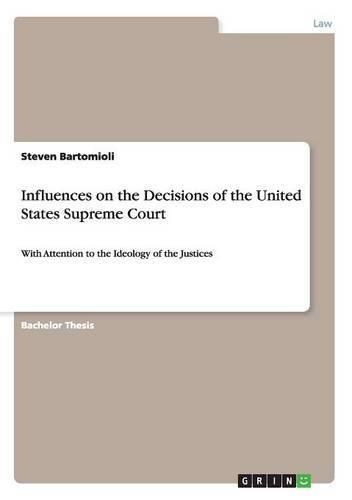Readings Newsletter
Become a Readings Member to make your shopping experience even easier.
Sign in or sign up for free!
You’re not far away from qualifying for FREE standard shipping within Australia
You’ve qualified for FREE standard shipping within Australia
The cart is loading…






Bachelor Thesis from the year 2014 in the subject Law - Comparative Legal Systems, Comparative Law, grade: -, Norwich University, language: English, abstract: What influences the way the Supreme Court decides a disposition of a case? Using data the Supreme Court Compendium ranging from 1946 to 2009 and varying sources of literature in the field, I developed several hypotheses: (1) On an individual level an increase overtime of the justices’ liberality; (2) the Supreme Court is influenced by public opinion directly or indirectly via Congress; (3) justices will offer opinions consistent with the ideals of their nominating President; and (4) the justices will formulate opinions consistent with that of the Chief Justice. Upon conclusion of my scholarly research and combination of data tables I found that there is a trend of ideology shifting from conservative towards more liberalism. Based upon the influence of the public on Congress I develop a new type of model I appropriately call the Legislative Model; the justices are policy driven. The president tries to nominate individuals with his ideology which shows through, however this can often be trumped by the influence of the Chief Justice on the ideology of individual justices. Based upon the research done for this paper, we can better understand what drives the opinions of the Supreme Court, directly and indirectly.
$9.00 standard shipping within Australia
FREE standard shipping within Australia for orders over $100.00
Express & International shipping calculated at checkout
Bachelor Thesis from the year 2014 in the subject Law - Comparative Legal Systems, Comparative Law, grade: -, Norwich University, language: English, abstract: What influences the way the Supreme Court decides a disposition of a case? Using data the Supreme Court Compendium ranging from 1946 to 2009 and varying sources of literature in the field, I developed several hypotheses: (1) On an individual level an increase overtime of the justices’ liberality; (2) the Supreme Court is influenced by public opinion directly or indirectly via Congress; (3) justices will offer opinions consistent with the ideals of their nominating President; and (4) the justices will formulate opinions consistent with that of the Chief Justice. Upon conclusion of my scholarly research and combination of data tables I found that there is a trend of ideology shifting from conservative towards more liberalism. Based upon the influence of the public on Congress I develop a new type of model I appropriately call the Legislative Model; the justices are policy driven. The president tries to nominate individuals with his ideology which shows through, however this can often be trumped by the influence of the Chief Justice on the ideology of individual justices. Based upon the research done for this paper, we can better understand what drives the opinions of the Supreme Court, directly and indirectly.